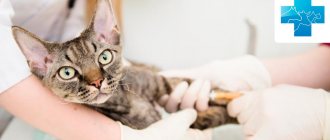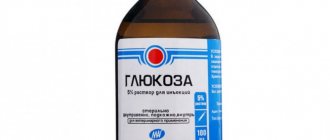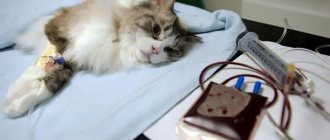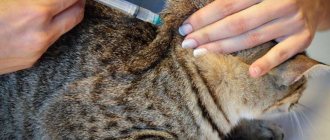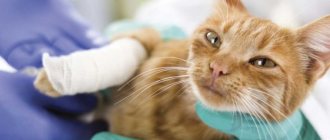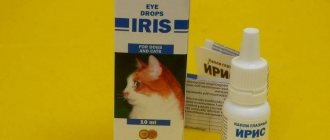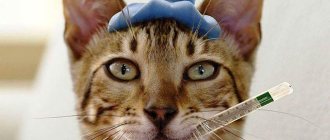Diabetes mellitus in cats is one of the most common diseases of the hormonal system, which is based on a violation of carbohydrate metabolism. The pathology mainly occurs in older animals, more often in neutered cats than in cats. In this article we will talk about why diabetes occurs in cats, why it is dangerous, and how to treat it.
What is diabetes mellitus?
Glucose is the body's fuel and provides energy to the body. Every cell of the body needs it; if it doesn’t receive it, it stops working and dies. Glucose enters the body with food, is processed in the intestines and absorbed into the blood. Then it is picked up by the hormone insulin, which is produced by the pancreas, and carried to the cells, where it binds to their receptors. Through them, insulin transfers glucose to tissues.
If the cell cannot absorb sugar, it remains in the blood and goes into fat reserves. When the body begins to starve and needs glucose, reverse reactions are triggered, during which fat is converted back into fuel.
Diabetes mellitus develops when:
- The pancreas produces too little insulin, and there is not enough of it to provide all cells with glucose. Pathological processes develop in tissues that have not received fuel. They begin to die and cause a malfunction in the body.
- Cell receptors lost sensitivity to insulin, stopped taking glucose from it, and began to starve against the background of high blood sugar.
How long cats with diabetes live depends on the owner. If an animal is treated, it will live a long time. If the disease is ignored, he will die soon.
Decoding the result
Increased glucose levels (hyperglycemia)
Observed in the following diseases and conditions:
- Diabetes.
- Gestational diabetes (diabetes during pregnancy).
- Physiological hyperglycemia, causes: moderate physical activity, strong emotions, stress, smoking, adrenaline release after injection.
- Active infectious process.
- Trauma, recent surgery.
- Endocrine system diseases:
- a) pheochromocytoma - a tumor of the adrenal glands that produces adrenaline and is characterized primarily by a persistent increase in blood pressure; b) thyrotoxicosis – a pathological condition in which the thyroid gland begins to produce too many hormones (thyroxine and/or triiodothyronine); c) acromegaly is a disease associated with a violation of the synthetic activity of the pituitary gland (a gland located in the brain). It is characterized by excess production of growth hormone, leading to changes in facial features, enlargement of the hands and feet. d) gigantism - a pathology, also associated with the pituitary gland, is hereditary in nature, the first manifestations occur in early adolescence; e) Itsenko-Cushing syndrome is a condition in which the adrenal glands produce excessive amounts of cortisol. Characterized by a violation of carbohydrate metabolism; f) somatostatinoma - a tumor of hormonally active cells of the pancreas or cells located in the wall of the duodenum, secreting somatostatin; g) polycystic ovary syndrome - a symptom complex accompanied by the formation of cysts in the ovaries, menstrual irregularities, excess body weight, and infertility.
- Diseases of the pancreas (acute and chronic pancreatitis, pancreatitis with mumps, cystic fibrosis, hemochromatosis, pancreatic neoplasms).
- Chronic liver and kidney diseases.
- Cerebral hemorrhage, myocardial infarction.
- Taking thiazide diuretics, beta blockers, caffeine, oral contraceptives, glucocorticoids (a full list is presented in the section “What may affect the results”).
Low glucose levels (hypoglycemia)
- Patients with diabetes may experience low glucose levels in the following situations:
- a) insulin overdose; b) overdose of drugs that lower blood glucose levels; c) increased physical activity; d) skipping meals; d) drinking alcohol.
- Severe liver diseases (cirrhosis, hepatitis, carcinoma, hemochromatosis).
- Tumor diseases: pancreatic cancer, adrenal cancer, stomach cancer, fibrosarcoma.
- Reactive hypoglycemia is a condition in which blood glucose levels decrease 1-3 hours after eating.
- Dietary disorders (prolonged fasting, malabsorption syndrome - impaired absorption of nutrients due to intestinal diseases).
- Taking large doses of alcohol.
- Intense physical activity.
- Feverish conditions.
- Taking a number of medications:
- a) beta blockers (atenolol, propranolol, etc.) – used in the treatment of coronary heart disease, hypertension; b) flecainide and quinidine (drugs for arrhythmia); c) indomethacin (painkiller); d) insulin and other hypoglycemic drugs; e) some antibiotics, antifungal drugs; e) aspirin; g) a number of antiepileptic, anti-anxiety drugs (pregabalin); h) monoclonal antibodies for the treatment of tumor or autoimmune diseases.
Types of diabetes
There are 2 types of diabetes mellitus in cats:
- The first type - the cells of the pancreas are destroyed, and it produces insulin in critically small quantities.
- The second type (90% of cases) – body cells lose sensitivity to insulin and stop taking up glucose. In response, the pancreas reduces insulin production, at a certain stage the process becomes irreversible.
Clinically, the forms are difficult to distinguish from each other. The only difference is that type 2 diabetes in cats can be reversed with timely treatment, type 1 diabetes cannot be reversed, it can only be slowed down. If the disease is not treated, the consequences differ little - the pet will face disability and death.
Causes of diabetes in cats
Diabetes mellitus in cats is a multifactorial disease, the development of which often involves several causes. Among them:
- Genetic predisposition – Burmese, Siamese, Russian Blue, Norwegian Forest, Abyssinian cats.
- Poor nutrition – a diet with a lot of carbohydrates (added grains, sugar).
- Overweight.
- Sedentary lifestyle.
- Endocrine diseases. First of all, these are pathologies of the pancreas. In 30% of cases, cats with diabetes have acromegaly, a disease of the pituitary gland, which is accompanied by increased production of growth hormone in an adult animal.
- Treatment with glucocorticoids.
- Urinary tract infections and inflammation of the oral cavity can cause diabetes in a cat due to the constant synthesis of stress hormones.
- Age – pathology often occurs in animals after 8 years.
- Gender – Males are more likely to get the disease than male cats.
Diabetes mellitus in cats: symptoms
The kidneys are responsible for removing toxins from the body, incl. excess glucose. Sugar has the ability to attract water. When glucose enters the urine, it takes with it fluid that should have remained in the body. As a result, dehydration develops. Hence, thirst and frequent urination in diabetes mellitus.
Other signs of diabetes in cats:
- Weakness of the hind limbs due to impaired nerve conduction and decreased muscle tone. Hence the plantigrade gait (a healthy cat walks on its toes) and problems with jumping.
- Tendency to bacterial diseases, primarily urinary tract infections.
- Severe hunger - a symptom of diabetes in a cat develops due to the fact that the cells are starving from a lack of glucose.
- Weight loss - the body begins to extract energy from fat reserves and muscles.
Another symptom of diabetes mellitus in cats is the smell of ammonia. It occurs when the liver breaks down fats, extracting ketone bodies, one of the elements of which is acetone. If there is too much of this substance (advanced stage), the animal begins to emit a specific odor. If the owner does not react urgently and does not call a veterinarian, the pet will soon die.
Diagnosis of diabetes mellitus in cats
The diagnosis is made based on signs of diabetes in the cat and blood tests:
- For sugar. Glucose in the blood of cats with diabetes increases, but the analysis cannot be used as a reliable diagnosis. The fact is that blood sugar in cats rises quickly under any stress, incl. when visiting a veterinary clinic.
- Fructosamine is a blood protein that binds to glucose, forming a stable compound. In diabetes mellitus, its level rises. The protein circulates in the blood for 2-3 weeks, so recent stress does not affect its concentration.
The value of fructosamine testing is reduced if the cat has hyperthyroidism (overactive thyroid gland). A diseased organ accelerates protein excretion, making it difficult to diagnose diabetes.
Blood and urine tests at home
Measuring blood sugar daily at home, when the cat is calm and relaxed, will help make an accurate diagnosis. Human blood glucose meters can be used for this. Then you need to show the results to the doctor.
A urine test for ketone bodies will help determine the pathology. The diagnostic test can be purchased at a human pharmacy. It will not show the disease at the initial stage, but if the pathology progresses, it will detect ketone bodies.
What may affect the results
Eating food, alcohol, certain medications, fatigue, or stress can affect your blood glucose levels.
Medicines that may cause increased blood glucose levels.
- Corticosteroid hormones (another name is glucocorticoids). They are intended to treat diseases caused by inflammation: rheumatoid arthritis, lupus, allergies. Systemic (tablet form, intravenous or intramuscular) steroids include hydrocortisone and prednisolone. However, topical steroids in creams and ointments or inhaled steroids (used to treat asthma) do not significantly affect glucose levels.
- Medications for anxiety, attention deficit disorder, depression and other mental health problems.
- Oral contraceptives (birth control pills).
- Some medications to normalize high blood pressure.
- Statins, used to lower cholesterol levels.
- Adrenaline (can be used for severe allergic reactions).
- High doses of non-inhaled asthma medications (given intravenously for severe attacks).
- Isotretinoin (used to treat acne and other dermatological conditions).
- Tacrolimus is an immunosuppressant (prescribed after organ transplantation).
- Some antiviral medications prescribed to patients with HIV and hepatitis C.
- Pseudoephedrine (a decongestant found in some cold and flu medications).
- Cough syrups (many contain sugar).
- Niacin (vitamin B3).
In addition to medications for the treatment of diabetes, the following medications and dietary supplements can reduce glucose levels:
- Aspirin.
- Aloe.
- Magnesium salicylate.
- Quinine.
To get the most reliable result, it is recommended to refrain from taking these medications until the test is taken, having agreed upon the timing of drug withdrawal with your doctor.
Female sex hormones also affect glucose levels, so a few days before your period, your glucose levels may be higher than on other days.
You can take a blood glucose test at the nearest INVITRO medical office.
A list of offices where biomaterial is accepted for laboratory research is presented in the “Addresses” section. Interpretation of study results contains information for the attending physician and is not a diagnosis. The information in this section should not be used for self-diagnosis or self-treatment. The doctor makes an accurate diagnosis using both the results of this examination and the necessary information from other sources: medical history, results of other examinations, etc.
Diabetes mellitus in cats: treatment
Timely treatment of diabetes mellitus in cats can, if not reverse, then stop the progression of the disease. If treatment is delayed and the symptoms of diabetes in cats are ignored, the prognosis is poor. Irreversible consequences will begin in the animal’s body, which will lead to disability and death.
If a cat has diabetes mellitus, the first thing to do is listen to the doctor and follow all the recommendations. Main methods of treatment:
- diabetes medications (insulin);
- special diet.
How to give an injection to a cat
Before injecting a cat with glucose subcutaneously, it is necessary to calm the animal, relax it and prevent it from becoming nervous. After this, you should carry out the procedure following the instructions :
- Secure the cat. The animal can be positioned in a way that is convenient for the owner for the procedure.
- With your left hand (for left-handers - right) take the animal by the withers and lightly squeeze it.
- Holding the cat with your elbow, slightly pull back the skin of the withers.
- With your right hand (for left-handers - your left), take a syringe with medicine and insert its needle parallel to the surface on which the animal is standing. The needle should not be more than a third under the skin. All movements should be made as smooth and confident as possible.
- Loosen your grip on your pet's withers and slowly release the glucose. Check that the drug is accurately delivered subcutaneously: if the cat’s fur does not become wet, then everything has been done correctly. Otherwise, the procedure must be repeated.
© shutterstock
After the injection, it is recommended to slightly stretch the pet’s withers so that the drug spreads faster in the body.
Insulin therapy
To treat diabetes in cats, insulin is prescribed to help control blood glucose levels throughout the day. Animal-based insulin is better suited for cats - bovine or pork (Caninsulin).
Synthetic human insulin is absorbed less well and is excreted faster, for example, it lasts not 24 hours, but 12. Among drugs of this type, Levemir and Lantus have shown good results.
How to treat diabetes in cats: injections or tablets
The tablets stimulate the pancreas, improving insulin synthesis, so they are not very effective if the gland is not working (in type 1 pathology). In addition, frequent use of pills can aggravate the condition of the pancreas and damage the liver.
Insulin injections do not give such a reaction. The hormone immediately enters the bloodstream, bypassing the pancreas, causing less damage to the liver. For this reason, doctors recommend insulin injections.
Importance of dosage
Before treating diabetes mellitus in a cat, it is necessary to correctly set the dose of insulin. The difficulty is that when an animal visits a doctor, its blood sugar rises due to stress. Therefore, the dose is prescribed based on measurements taken by the owner at home. If the cat owner is unable to do the test during the day, the dosage is prescribed based on the level of fructosamine in the blood.
In most cats, positive dynamics begin a few days after taking insulin. The recommended dose is 1-2 injections per day.
The importance of monitoring your pet's condition
A sick cat should have its blood and urine glucose levels measured daily. Keep in mind that different brands of insulin affect cats differently. Some medications may last less, while others may last longer.
Monitoring blood glucose levels will help adjust the dose, depending on the type of insulin and the health of the cat. The data obtained during the measurements must be recorded in a diary. It must indicate:
- insulin injection time;
- medication dosage;
- blood and urine sugar levels;
- quantity and time of feeding;
- volume of liquid drunk;
- cat's weight (once a week).
The veterinarian will need this data in order to adjust the treatment regimen in time. You cannot change the dosage yourself if the cat feels better or worse. Moreover, it is forbidden to stop taking insulin without your doctor’s instructions.
Insulin overdose: consequences
If you give your cat too much insulin, his blood glucose levels may drop to critical levels (hypoglycemia). Symptoms:
- weakness and lethargy;
- shiver;
- staggering (drunk gait);
- convulsions;
- loss of consciousness;
- vomit;
- loss of bladder control.
Hypoglycemia is a deadly condition that requires urgent medical attention. To revive your cat while you wait for the doctor, rub honey on her gums.
How long should you mix a 5% glucose solution and an ascorbic acid solution for a cat?
Inject glucose with saline in half, the finished mixture subcutaneously at the rate of 10 ml per kg of animal weight.
And is it possible to give glucose not subcutaneously but by mouth? It's been a week since the cat has eaten. She also had specific poop: yesterday she pooped for the second time; it was hard on the inside, but on the outside it looked like meconium, the consistency of fuel oil.
You need to give your cat a glucose solution. Can it be given orally or only subcutaneously?
It can also be taken orally, ideally it is better to instill it into a vein.
8. Glucose 5% solution for injection is used subcutaneously or intravenously, and glucose 10,25,40% is used intravenously in the following doses of ml per animal
Why do you need to feed your cat glucose?
The veterinarian prescribed glucose subcutaneously to my cat (put it at the withers). But this is out of necessity - the cat is sick. But you don’t need to just give glucose
If you have a bladder disease, for example, apply it subcutaneously to the withers.
Is it possible to inject a cat with glucose subcutaneously?
Go to the vet. It will be more reliable.
Glucose 5% solution is used subcutaneously or intravenously. Glucose 5%, 40% is a veterinary drug. Instructions for use, properties, description, characteristics, discussion, watch, download.
How do you love your cat, though?
You are unlikely to help him at home, at the vet. I need a clinic. You won't cure it with glucose alone. Moreover, it must be dripped subcutaneously and cannot be injected as a stream.
Three days is not a long time for animals.
It is possible and in this case even necessary. Prick at the withers. This will protect you from dehydration and maintain strength. But it's best to take it to the vet. Why are you delaying, why are you waiting to take him to the hospital, it won’t go away on its own. Glucose is specifically for injection, and not just any kind.
5% glucose 4 cubes + 12 cubes of isotonic sodium solution - only in this form under the skin - one glucose - necrosis!
Do an ultrasound, and in the meantime give the cat glucose 5% and saline solution 20 ml Gamavit 2 ml subcutaneously 2 times a day - Entrosept 0.5 ml subcutaneously 1 time a day - glucose 5% 20 ml Essentiale 2 ml 1 time a day - Ringera locke.
Only on veterinarian recommendation
Veterinary medicine: tell me, which is correct: saline and glucose are injected intravenously or subcutaneously? Thanks in advance cat
Subcutaneously, if into a vein, then only a dropper
Or rather, where and how much to inject. Pepper has acute gastritis after poisoning...all dried up. weak.. glucose is 5% solution. help. You can use syringes subcutaneously at several points, or you can also subcutaneously, but through a dropper 100 ml in one place….
It can be done either way, or even intravenously.
Intravenously. It can also be done subcutaneously. But not intramuscularly, the volume of liquid is too large.
A saline solution with glucose is administered in large quantities; there is no point in injecting it intramuscularly, only if it is administered subcutaneously or intravenously through a dropper.
To the house. conditions only subcutaneously. lift the skin on the back to the right and left of the spine and insert it into the air cavity. The lump will quickly resolve. Do not be afraid. Nothing complicated...
Question for veterinarians and knowledgeable people. What physical the solution is more nutritious than glucose (subcutaneously for a cat).
P\C can only be glucose 5%, and Ringer's solution., and sodium chloride 0.9%. That's all, the only thing you can “flavor” glucose with is the vitamins pyridoxine-B6, cyanocobalamin-B12, ascorbic acid-vit. C, and also cocarboxylase. The rest is just in a vein. What happened?
If a newborn kitten does not have any internal organ defects, then it can be saved. Twice a day, inject subcutaneously with 0.3 ml of gamavit, 0.3 ml of catozal, 0.2 ml of traumatin. Inject a vitamin cocktail with 1 ml of 5% glucose.
How many cubes of each solution should a cat be injected - he tolerates a glucose injection (20 ml) very painfully, what is the duration of subcutaneous injections (the injection lasts 5 days)?
The cat was injected subcutaneously (at the withers) with 40 ml of glucose (5%), he is all gurgling (2 hours have passed) and is sleeping, is this normal?
Glucose has nothing to do with it, your cat seems to have heart failure (either the consequences of poisoning, or the IVs were rapidly dripping), so there is fluid in the lungs, and therefore shortness of breath. Check the mucous membranes for bluishness, and at least call your veterinarian. Otherwise, tomorrow there may be no need to go.
My cat was diagnosed with chronic renal failure. Siamese cat, not castrated, not vaccinated, age 13 years, domestic 10-80 units-l, ours is 20.4, alkaline phosphatase norm is 39-55 units-l, ours is 100.6 , glucose up to 6 is normal, ours is 6.3. Today they injected subcutaneously...
In case of poisoning, the cat was given glucose and other medications subcutaneously. Will they be beneficial?
Of course, he was fed with glucose and is now being treated
Our veterinarian who performed the operation on her. I was advised to go to the pharmacy and buy glucose so that Only as it turned out later, I gave it not intradermally, but subcutaneously... the cat became seriously ill...
If the veterinarian has selected the medications, it will be beneficial.
Will
The cat got sick. Apparently he was poisoned, we only have guesses. We think poisoning.
Why can't I inject glucose? at this rate he really... that... . In general, he needed help earlier, when it all just started, but now, I don’t even know...
Otherwise, treatment will do more harm than good! So, for example, a glucose solution for On the one hand, making them is much easier, because a subcutaneous injection is given to the cat. In addition, during mating, the cat holds the female tightly with his teeth, also by the withers, so the skin is there...
Well, wait until it dies, there is nothing else left, cats cannot starve for more than 3 days, they develop liver atrophy, and soon the animal dies... Plus you're poisoned. I don’t understand this kind of care for animals; if there is no way to give a decent life to an animal, then don’t get one. And such a pity, this is not pity but mockery!
Glucose 5% subcutaneously, try to find a human doctor or paramedic to drip into a vein. Subcutaneous application is very simple, take the skin at the withers with your hand and insert it into the base, across the fold. As soon as it resolves, add more, you can alternate with physical therapy. solution, 2-3 20 gram syringes can be used at a time. Find a veterinarian forum and post there.
Give him a little diluted alcohol or vodka.
Cat, 4 days after sterilization. Not eating, not drinking.
Try it for yourself and you’ll understand what’s going on
Glucose is used as a means to remove toxins from the body and replenish fluid losses. If the cat has frequent vomiting, the cat does not eat anything, it is necessary to administer an antiemetic drug. Cats are administered intramuscularly or subcutaneously 0.3 ml. 2 times a day.
She’s offended because she was deprived of her maternal instinct, she’s thinking about what court to sue you for, and doesn’t have time to eat.
Are your gums pale? Does the cat even receive an antibiotic? Who did the surgery? Maybe it's worth talking to him? She is severely dehydrated, it’s high time to give her an intravenous fluid infusion +, as I understand it, glucose too... Do not self-medicate, contact a cat specialist!
It is not normal. Contact the person who operated. Mine was already jumping all over the apartment on the 2nd day after the operation, as if nothing had happened, not to mention the beastly appetite%)
Well, if you are a doctor, then you must understand that this should not happen (!). A day of recovery from anesthesia, which can happen after this operation (occasionally and not all), is temporary urinary incontinence in a cat (a day or two), constipation (can be cured with 1 cube of Vaseline oil! Everything else is PATHOLOGY!!! And requires immediate treatment hospital where the operation was performed!! By the way, they should have given you a reminder (MANDATORY) of what and how to do with the cat, how to care for it after the operation - IF YOU DON’T HAVE THIS, then think about the competence of the surgeon and the reputation of this clinic !!!!! If there is a typo - then within 24 hours - this is of course the norm))))!
“I live in Paradise” actually it was immediately written that in the photo she was still small and there was no need to invent anything about her poor eyes!!! It’s good that she was sterilized, otherwise there are quite a few stray animals in the country! but on the other hand, most likely the cat was offended because she was deprived of her motherhood, but you still did the right thing!)
Having said that, there is no dehydration of the body in the sense of critical, due to the subcutaneous administration of glucose, but in a cat in serious condition, the kidney is greatly enlarged and its chances are small depending on whether the kidneys and heart can withstand it.
Go to the vet immediately!! ! Intestinal paresis cannot be ruled out (stool on the 2nd day is not an indicator, if only once and not a lot). If you can, listen to peristalsis. If not available, it is optimal to use prozerin based on weight. An antibiotic is a must. Subcutaneous physical solution, glucose, again based on weight. About the offense - complete nonsense. For those who condemn sterilization. My cat was much more unhappy in heat than after being spayed. Instead of thoughts about cats, excellent appetite, stable weight and thick fur, not to mention the improvement in character.
I should take mine for sterilization tomorrow because I’m scared
Help please
Perhaps worms...?
I gave 2 ml to a small kitten, but I don’t know how much to give to an adult cat. Subcutaneously. At lunchtime I gave injections of fosprenil, noshpa, and cefazonil. In the evening I will give the same again, plus some glucose subcutaneously.
It would be better to go to the vet
He got sick of it. Give him milk, milk is healing for them.
Is the cat long-haired? It is quite possible that the wool clogged the intestines. he's licking himself.
Worms... Let's eat less raw foods. at least scald... and river fish is contraindicated
What do you actually feed? Dry food with natural ingredients is not digestible. And what kind of dry food? Vomiting can happen for many reasons. After all, vomiting is only a consequence. and how does he go to the toilet? You need to see a doctor, there’s nothing to say here.
What physical the solution is more nutritious than glucose subcutaneously for a cat. PC you can only use glucose 5%, and Ringer's solution., and sodium chloride 0.9%. That's all, the only thing you can flavor glucose with is the vitamins pyridoxine-B6, cyanocobalamin-B12, ascorbic acid-vit.
Kitty got poisoned
It will heal like a cat
Glucose in organs and tissues is phosphorylated, turning into glucose-6-phosphate, which activates the body's metabolism. Slowly, subcutaneously - cats, rabbits 10-30 ml of the drug intramuscularly, ulceratively, subcutaneously.
You still need to find out from your grandmother what the cat was poisoned with, and then treat based on this
It's okay for now. Consequences of poisoning. If tomorrow he is just as lethargic, take him to the vet.
He doesn’t eat... that means he doesn’t want to. He will recover. And how to understand this... she didn’t give anything like that. But she gave something. Maybe lard or a piece of sausage. Sour milk or sour cream.
Of course, ideally, see a doctor. At home - forcefully pour in water (it is very important that the animal drinks) and water with Rigedron (in a human pharmacy) - this will clean the intestines
Ideally, of course, to the vet! And if you do it yourself, crush the activated carbon, add a little water and into the mouth (you can insert it using a syringe without a needle)
Subcutaneously administered glucose begins to enter the blood within 5 minutes, and after 20-30 minutes the animal’s life is no longer in danger. If you administer five cubes, there will simply be no need to administer a new dose after a few hours. Unless you gave the cat a…
More like panleukopenia, although not a fact. Go to the vet immediately.
If he doesn’t eat and he’s sad, then let’s put it bluntly - CRAP! If you want to see how it ends, wait, but it’s 50/50 that he’ll glue the fins together! Otherwise, go to Aibolit! But aibolit are not cheap these days!
Help urgently, the cat is sick!!!!
Stones in the kidneys! which cestitis? run to the ultrasound
Where to give a glucose injection to a cat. Glucose is injected subcutaneously into the cat's withers, where the animal feels almost no pain. What is needed for injections.
Why didn't you drink? ..I don’t know, our dog didn’t eat or drink, so the veterinarian put her on an IV, maybe your cat needs an IV, otherwise I don’t think dehydration will lead to anything good... Why didn’t they take the doctor’s number? He knows better
Take the cat and see a doctor immediately!!!! install a new catheter, droppers to relieve intoxication!!!! Ultrasound, blood and urine tests. don't delay!!!!
I'm also for the doctor! And without delay! I didn't drink anything, that's bad.
It looks like urolithiasis. Urgently see a doctor, otherwise you won’t save the cat!!!
Contact your doctor again! Be sure to do an ultrasound
Both the heart and the kidneys will fly! There is no way to install an IV, give yourself 5% glucose subcutaneously, a syringe of 10 cubic meters - 2 such syringes several times a day, calculate the dose based on the weight of the cat, only do not exceed 20 cubic meters at a time...
Most likely the cat has urolithiasis. Buy Kotervin at a pet store and give it according to the instructions. Should help. In any case, it helped my friend’s cat, and more than one.
How much does it cost to put an IV on a cat for dehydration? And is it possible to find a cheaper way to help an animal? (Kyiv)
Maybe it's better to get him drunk
The cat is 2.5 years old. Not vaccinated. Last Monday, a mother picked up 2 kittens at the entrance. Both died suddenly. Be sure to inject 5% glucose saline solution subcutaneously to prevent dehydration and maintain the body.
Inject subcutaneously, but without eliminating the cause that caused this condition, you won’t get far
Ask the vets to install a catheter in the cat’s vein and show how to use it to insert IVs themselves. True, then you will have to make sure that the cat does not take it out on his own. Then you can drip at home for 3 days. You can inject the cat subcutaneously yourself, but the effect will be much worse. It is also possible to force an animal to drink.
Eat. Pour half a teaspoon into the mouth with Ringer's solution, alternately with 5% glucose every half hour for 24 hours without a night break.
The cat dies, and he saves money!! ! Is it the same with friends?
The cat has a low temperature
Take the cat to a proper doctor. and to “carry it through” you can use castor or Vaseline oil. True, it might make you sick.
Glucose 5% warm subcutaneously 3-4 ml per day. Fosprenil 0.5 ml orally 2 times 10 minutes before feeding. Liarsin 0.5 ml subcutaneously once a day is also good. And feed them yourself every 2 hours.
Go to a third doctor, or better yet, call a doctor at home... Don't leave the cat in this state... Ours had something similar, he also lay there and still whined (but I don’t know what his temperature was). I immediately called the doctor home, the doctor gave the cat an enema and 2 injections and it got better. And in general, when I see that the cat is really bad, I immediately call a doctor home, we have round-the-clock veterinary care and the doctor is very good, the cat is not afraid of him, he lies calmly (there is no stress, like in the clinic). Get better... By the way, the doctor said to give the cat Vaseline oil (fill it in a syringe and pour it into the mouth, but pour it from the side so that the cat doesn’t choke). There is no addiction to Vaseline oil; it passes through the intestinal tract in transit without being absorbed anywhere). And how much to pour in, you can see for yourself what dose will work on the cat) . And we need to find out the cause of constipation.
Of course, put on an IV!! ! And we urgently need to raise the cat’s temperature!!! ! Cover him with heating pads + a warm blanket, in short, keep him warm! And against the background of what does the cat have such ANEMIA?? ? develops, what is the diagnosis? But I read: the cat drinks a lot. Look at the indicators of Createnine + Urea = according to blood biochemistry. I hope the cat has a negative test for PKD (DNA) ;-))
Help, the cat is constantly vomiting
Check him for worms, if there are any, take preventive measures.
I understand that it’s a shame, I myself have a cat who is 5 years old. Try to go out with him to the grass, he will find what he needs on his own. cats It’s just that I somehow injected glucose subcutaneously after a tooth was removed under anesthesia, maybe I can inject it subcutaneously now??
Oh my God! What a pity! Could your cat already have intestinal cancer? Obstruction of solid food most likely. Or some complex worms, or a tumor. With gastritis, there should be no smelly vomit. Here the food is clearly processed by pancreatic juices and only then does vomiting begin. Milk is generally very difficult for the body to process. Collect some money, get tested for tapeworms, and be sure to be examined for oncology. (write in a personal message, I’ll help you with money as much as I can) Drink some water more often. And pureed highly liquid food just like semolina, feed it in small portions, brew rice in a weak chicken broth, puree it, only remove the skin from the meat. May God bless the cat and give you patience. Don't abandon the poor animal. Please.
Cats should not be given milk! It is not absorbed at all in adult animals. Go to a normal doctor, buy medicinal food, but in the meantime you need to inject 5% glucose under the withers, at least 10-15 cubes a day, why are you torturing the animal! A weak chamomile decoction from a syringe, alternate with boiled water (if you don’t drink it yourself) as often as possible. What color is calla? It is imperative to do an ultrasound, then the diagnosis will appear and it will be clear what to treat
Milk, rice and boiled chicken go into the trash. cat - cerucal from food - RoyalCanin Intestinal - pieces in sauce - for problematic digestion, look for veterinary homeopathy HELVET - Liarsin + Veracol cat drip subcutaneously 25-30 cubes - saline + glucose
Give Entorosgel 3 a day, don’t feed him at all during the day, feed him a little the next day and at least give him this medicine (this is a human medicine, but it helps a lot, the veterinarian advised me), the next day everything began to go away for my cat, then it went away completely, the medicine helped for almost a day, after that we just watched what she eats, and so that she doesn’t get anything from the table,
What to do if you can’t put an IV on your cat?
Consult your doctor
If you can’t feed a cat or cat, it starts vomiting or eats very little, then you need to inject a 5% glucose solution subcutaneously into kittens - 5 ml 2 times a day; adult cats - 20 ml 2 times a day. In this case, the infusion will be...
Have it checked at the veterinarian
I gave injections of glucose solution into the withers.
You can apply it subcutaneously to the withers area. (5% glucose, saline)
Why do you call someone idiots, you were advised correctly... If you can’t do it yourself, take them to a veterinary clinic for IV drips... Or inject saline and glucose subcutaneously... And what other advice can there be???
I feel sorry for the cat. Do everything you can. Consult. This is a member of your family.
It is necessary to inject 20 ml of saline solution and 5% glucose under the skin at least 5-6 times a day. Anywhere. My cat had a weight loss of 7 kg. Pull back the skin on the withers and inject subcutaneously up to 100 ml. liquids alternate between glucose and saline 2. pour into the mouth every 2 hours not...
Subcutaneously in the withers or thigh, saline solution or glucose 2.5 or 5%, everything they write to you is correct.
I agree with Akasha. It needs to be checked by a veterinarian.
In order for the animal not to become dehydrated, the cells must not lose salt and retain water. The rehydron solution is injected slowly into the cheek with a syringe without a needle so as not to choke. A regular packet of rehydron is poured onto a sheet of paper, make a path of powder and divide it into 20 parts - dilute it with water (50 ml, more is possible). And you drink it during the day in 3-8 doses. For one thing, these same salts support the functioning of the heart.
What to do if a cat vomits brown worms approximately 5 cm in size? And how dangerous is this for humans?
It’s not dangerous for you if you don’t kiss the cat, but take the cat to the vet if you feel sorry for him at all..
If a cat receives more than 2 units per kg of lantus or levemir, and glucose levels remain high, then we are talking about insulin resistance and should try to find out its causes.
I don’t know about people, but the cat probably has worms.
Show the worm to the doctor - in a jar and in the refrigerator. Then you will find out. And the cat needs to be regularly wormed. And get your vaccinations on time.
Drontal is correct. But I feed mine with regular decaris. Occasionally, for prevention. Read the instructions per kg body weight. But…. How can you bring your cat to this point... huh? It is possible and necessary to remove worms. Isolate from children if possible. But if you love your cat, then get rid of the worms - and your cat will be healthy and make you happy. Don't throw away...
You can use cestal, kanikquantel
The whole family needs to be wormed, not just the cat. Drink DEKARIS for prevention. Thoroughly clean the entire apartment with bleach.
10. Glucose 5% solution for injection is prescribed subcutaneously or intravenously. Glucose 10%, 25%, 40% solution for injection is prescribed only intravenously. Depending on the severity of the disease, the drug is administered to animals 1-2 times a day in the following doses
The cat needs to go to the vet ASAP!!!
Give him not Prazitel suspension, but more effective drugs for helminths, but it is better to take him to a veterinarian and collect what he vomits in a container for analysis. The whole family also needs anti-worm medications as a preventive measure! If you give raw beef, this is quite possible.
The cat and cat don't eat! Poisoned with dry Whiskas???
Take your animals to the veterinary clinic immediately.
Only 5% glucose subcutaneously. Saline solution 3 ml glucose and 2 ml sodium chloride all in one syringe. This is for one kg of weight!!! Is it possible for a cat to cut the fur between its fingers? slides on the laminate...
Whiskas in the trash!! !
They're on a hunger strike
Go to the vet urgently... Possibly pancreatic problems from whiskey... very bad food
1 You CANNOT feed both natural and industrial food. And even more so, you suddenly switched so abruptly, even if only for a couple of days. 2 YOU CAN’T give whiskey/friskas/kitikat to animals 3 Monitor your stool and temperature, and behavior. If everything is as always, then don’t panic. If something is wrong, see a doctor
OH, WE KNOW WE HAVE PASSED, THEY GET USED TO THEM AND THEY DON’T WANT TO EAT ANYTHING ELSE SO BUY THEM WHISKAS AND THEY WILL ONLY EAT IT MINE TOO IF THERE IS NO WHISKAS EXCEPT FISH AND MILK EVERYTHING IGNORES! YOU CANNOT BE POISONED BY THEM! Well, I didn’t have such cases... It’s just that this whiskey is very tasty without it…(that’s what cats think)…. in general, try mixing whiskey into regular food and they will eat it too! CHECKED!
Hello! I have the same problem. My cat is 15 years old. He recently got sick and completely stopped eating. You can finish him off with glucose. Inject Reosorbilact 40 ml subcutaneously.
Never feed Vikas. Either good drying or a balanced natural - this has nothing to do with food at the human table. Judging by the way you feed the cat, I would choose dry food and not worry. Fish should not be given often.
Ugly clinic. call another one. but don’t give him food and give him some grass from the lawn. They will fast for 3 days and leave on their own. You can’t give the Whiskas brand, throw everything away.
We fed all seven of our cats kitikat!!!! So, throw whiskey in the trash, but with cats, either separately or with someone else, go to the vet or write on the website, or call and ask what it is and when you can come. Let them do a stomach examination.
Stupid - milk - not allowed for cats - categorically...and dry normal food - Hills Proplan Pronature Ekanuba...poisoning - glucose 5% 20 ml + there B-12 subcutaneously...WHAT DO YOU NEED _SAVE THE CAT OR DIAGNOSIS _ DO IT URGENTLY...
Why are you feeding your cat this old crap? feed capelin with porridge, a natural diet
Mating a cat WITHOUT exhibitions and referral to a cat is a crime against the breed! Inject 0.1 ml subcutaneously with insulin. glucose 5% several ways to use and for an eclampsia cocktail in 5 cc. syringe 2 ml glucose, 2 ml calcium borogluconate and 1 ml ascorbic acid...
They didn’t get poisoned, but out of habit they clogged their intestines. everything will pass or let them dig in
Constipation could happen. If you haven’t gone to the toilet for 2 days and your tummies are full, give 10 ml of Vaseline oil through a syringe without a needle. A little later, Enterosgel or an Act tablet. coal If they go to the toilet, then just Enterosgel or charcoal.
Remember the basic rules for feeding cats and dogs. Decide, or dry food, BUT GOOD SUPER PREMIUM CLASS. Find out at the pet store, there are many of them. Or still natural food, it must be balanced: trozhok, boiled chicken breast, turkey, beef, egg yolk, offal - chicken hearts, gizzards, (not often) oatmeal porridge, semolina - also not often. Boiled vegetables - carrots, tsv. cabbage, zucchini. Kefir. MILK IS GENERALLY ABSOLUTED ONLY IN KITTENS UNDER 3 MONTHS OF AGE. Adults can sometimes, BUT DILUTED WITH WATER AND PROVIDED THAT YOU DO NOT FEED DRY FOOD. WITH DRY FOOD YOU CAN ONLY GIVE WATER AND THAT'S ALL!!!! FISH IS ALSO NOT RECOMMENDED FOR CATS. About whiskeys, friskas and other crap, completely forget it. Cats get used to it, then you can’t wean it off. There's a lot of chemicals in there, but no more than 5% meat. There is no dependence on good food and there is no chemical in it. IT IS NECESSARY TO TRANSFER FROM DRY TO NATURAL AND VICE VICE GRADUALLY, OVER SEVERAL DAYS, REPLACING PART OF THE FOOD. Health for your animals. Watch your stool, usually these foods cause diarrhea. If it doesn’t go away, maybe it’s really constipation, you can give Vaseline and monitor the temperature, if it worsens, then take it to the doctor. TO ANOTHER!!!!
Please tell me what to do?
How can I help you? give a kick to the vet?
Cats. Cocktail stimulating labor. Glucose 5% 4 ml. Roughly speaking, the result occurs subcutaneously in 10 minutes, in the muscle - in 5 minutes, in the vein - instantly.
The nose is not a sign of disease
Wait for the vet and run to him. Also take your temperature and read it on the internet.
Could be worms!
The cat has been lying for the second day after the operation, as if sleeping very soundly.
Of course, the operation was serious.
I administered Glucose and Ringer's solution subcutaneously from a human pharmacy, 10 ml each. 3 rubles of both. per day or more often with frequent vomiting. The cat himself could not drink and did not want to. He lay flat with a strong fever and fever.
It’s normal - don’t touch the cat and let him recover!!
My cat has not yet recovered on his own, we did not touch him. there was always water nearby. while no one was paying attention to him, he stood up, drank some water and lay down again
Causes of vomiting in a kitten
Google it I sympathize (
Biochemistry in the second clinic Urea - 31.09 mmol l norm 4.0-11.0 Creatinine - 531 µmol l norm 60-170 Glucose 8.69 mmol l day, 10 days 7 Furasimide 0.5 ml subcutaneously, 1 time per day, 5 days. After 7 days of treatment, we went to the attending physician, explained that the cat...
Don't give him moonshine
There may be something blocking your throat, or an infection.
He eats? Drinking? poop? It could be anything. Traditionally, it is better to show it to a doctor.
Fur in the stomach, poor diet, some kind of inflammation, worms... take it to the vet, let him examine it
Maybe he ate something wrong, maybe he had worms, maybe he overate (happens in kittens), maybe he ate litter... Mine once couldn’t spit out the fur, maybe it’s an illness, o If the kitten is vomiting, you need to find out the cause of the vomiting as soon as possible. Perhaps nothing terrible is happening and the vomiting is one-time in nature. Or perhaps your kitten (cat) is seriously ill and without timely assistance he will die. Causes and treatment of vomiting in a kitten (cat): poisoning and each cause has its own method of treatment... If the kitten is vomiting, you need to find out the cause of vomiting as soon as possible. Perhaps nothing terrible is happening and the vomiting is one-time in nature. Or perhaps your kitten (cat) is seriously ill and without timely assistance he will die. Causes and treatment of vomiting in a kitten (cat): - a kitten vomits if it has eaten too much. This happens if a hungry baby is given a lot of his favorite food, the baby overeats and, as a result, vomits. Usually such vomiting in kittens is one-time. But if your kitten vomits every time after eating, then you should take him to the vet as soon as possible. The causes of such vomiting can be disturbances in the functioning of the digestive organs, as well as various diseases, both genetic (for example, narrowing of the trachea) and acquired. — the kitten is vomiting and there are worms in the vomit. Often, helminthic infestation causes the kitten to vomit. This is very dangerous and can lead to death. Timely deworming will help prevent helminthic infestation. If the kitten is infected, then you need to give it anthelmintic drugs (if vomiting, drops are applied to the withers), and the kitten also needs treatment. Contact your veterinarian and he will prescribe appropriate treatment. And to support the normal condition of a sick kitten, before visiting a doctor, subcutaneously inject the kitten with 0.5 ml of Gamavit, 0.5 ml of Liarsin, 0.5 ml of Veracol 2 times a day for at least 10 days. — the kitten is vomiting due to improper feeding. This is possible when feeding a kitten (cat, cat) with cheap food, food from the table (cutlets, sausage, etc.). Gradually, the kitten’s digestive system becomes disrupted and the kitten’s vomiting may become constant. With such vomiting, the kitten (cat) is given super-premium dietary (medicinal) food and given probiotics to restore the microflora. — the cause of the kitten’s vomiting is poisoning. A kitten is a small child, very curious and who wants to taste everything. Therefore, keep everything that can harm your baby’s health behind closed doors: medicines, household chemicals, vitamins for animals, etc. And a kitten can also get poisoned after getting close to indoor plants, many of which are toxic to animals. If a kitten is poisoned, immediately give it a sorbent, for example enterosgel, inject 1 ml of Liarsin subcutaneously and call a veterinarian. - Sometimes small kittens can eat cat litter. It is very dangerous. The kitten begins to experience severe vomiting and diarrhea. Dehydration sets in very quickly. With such nausea, the kitten cannot be given drugs in its mouth; it will still vomit them. The drugs are given only in the form of injections. Every 2 hours (and at night too) 2 ml of Glucose or Ringer Locke solution subcutaneously to prevent dehydration. 2-3 times a day Liarsin and Veracol (can be in 1 syringe) 0.5 ml subcutaneously. Gamavit 2 times a day, 0.5 ml subcutaneously. Give all medications until the kitten has fully recovered. - vomiting in a kitten as a symptom of the onset of the disease. The kitten vomits with many serious infectious diseases. If the kitten has not been vaccinated against infectious diseases, the baby has severe vomiting with diarrhea and a high temperature, call a veterinarian immediately. Nausea in cats and kittens is quite common. In adult cats and kittens, vomiting is often caused by excess fur. All animals lick themselves and the fur clogs the stomach and intestines.
Made ceftriaxone, 5 glucose, 40 ringer, subcutaneous sodium chloride with cocarboxylase. Recent history April 11, 08 00 - Fax - 40 ml of ringer subcutaneously, the cat is lying on the table like a king, chasing my Tiny.
Whatever!
There is no vomiting, only the urge to vomit, the kitten is active, plays, eats, sleeps - everything is normal, only occasionally these urges begin, it has been treated for parasites, the fur cannot be - the kitten is small and not long-haired - no more than 2 months old, won't have time to accumulate
Why is my cat throwing up?
Do not feed grass and rotten fish
How much glucose can you inject a cat subcutaneously? How to support a cat. Glucose is administered subcutaneously in the area of the withers, where the animal feels almost no pain.
Yellow vomit is a sign of poisoning. Don't feed dairy yet. Arrange a diet. If it doesn’t go away in 3 days, go to the veterinarian (we had the same thing; the cat turned out to have a serious stomach disease, the cat died; (
In a bottle of 200 ml. Pour 5% glucose from a syringe by breaking through the rubber stopper into 2 ampoules of 2 ml. 10% vitamin “C” (sold in a pharmacy) and mix, give 20 ml injections under the skin on the back. 2 r. a day in the morning and evening for 5 days. Injections of vitamin B12 into the muscle of the hind paw, 1 ml. 1 ruble a day for 5 days. Also vitamin “B1” (can be given subcutaneously as it hurts). The interval from injections is 1 hour! Especially vitamin “C” from vitamin “B12” can be taken for 2 hours. You can use the same syringes, just wipe the needle with alcohol. And slowly feed warm dairy products, fermented baked milk, yogurt, kefir in portions from a syringe.
Yes, whatever you want, it can be, and any advice without examination and diagnosis is inappropriate! Just don’t rush to poison worms with such symptoms, they have nothing to do with it!
He's shedding now. Licks its fur and swallows. Then he burps.
Cats “wash” themselves, that is, they lick themselves. Of course, they swallow wool, and then SHE vomits them))
These drugs are sold in a human pharmacy. The third is replenishing lost fluid. Whatever dehydration develops, you can inject 5% glucose or saline solution subcutaneously.
There may be poisoning, a viral infection, pancreatitis, hepatopathy, gastritis, a foreign body in the stomach, etc. Watch for another day and if anything happens, see a doctor!
Nutrition for cats with diabetes
In case of diabetes mellitus, special attention should be paid to nutrition:
- You need to feed your pet 4 times a day at the same time.
- When scheduling feedings and injections, you need to calculate the time when insulin in the blood is at its highest level (usually 3 hours after the injection). Feed as follows: give 2 snacks before the injection, 2 (main feeding) - 3 hours after the injection.
- Give preference to a diet with a low amount of carbohydrates (up to 5%), from which the body extracts glucose.
What to feed a cat with diabetes
The diet should be based on lean meat - beef, lamb, chicken, turkey, which are the main source of protein. Don't forget about vegetables (carrots, cabbage, zucchini), which slow down the absorption of glucose. Salt, spices, pasta, smoked meats, and other food from the master's table are prohibited.
Do not mix:
- natural food with industrial food;
- drying and canned food.
Provide the animal with constant access to water.
Cat food for diabetes
It is better to regulate your cat's glucose with a low-carbohydrate diet, so buy special medicated food. Take a product that belongs to the super-premium and holistic class. Cheaper products are high in carbohydrates (cereals), so they are not suitable for diabetes.
Never buy economy food, especially if your pet is sick. They have an unbalanced composition, a lot of harmful substances, grains that can cause a sharp jump in sugar.
Blood glucose test
Glucose is an organic compound that is the main source of energy for the body's cells and the only one for the brain and nervous system. For the normal functioning of all organs and systems of the body, a relatively constant level of glucose must be maintained. During digestion, carbohydrate sources are broken down into glucose and other nutrients; they are absorbed by the small intestine and distributed throughout the body. The use of glucose for energy depends on insulin, which facilitates the transport of glucose into the body's cells and stimulates the liver to store excess energy as glycogen for storage.
Typically, blood glucose levels rise slightly after eating, and the pancreas responds by releasing insulin into the blood in an amount appropriate to the size and content of the meal. As glucose enters cells and is metabolized, blood levels drop and the pancreas responds by slowing and then stopping the release of insulin.
Prevention of diabetes
- Monitor your cat's weight and prevent obesity.
- Pay attention to a balanced diet. Remember that the cat is a carnivore, so meat should dominate the menu. Reduce the amount of carbohydrates. If you feed artificial food, it must be of high quality.
- Provide your pet with plenty of exercise, especially if he doesn't leave the house. Play with your pet daily, providing moderate exercise.
- Regularly donate your pet's blood and urine for analysis, if there is a genetic predisposition, the pet is over 7 years old.
- Treat illnesses in a timely manner. If the pathology requires the use of steroids, reduce their amount to a minimum, especially if the pet is obese.

